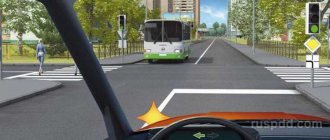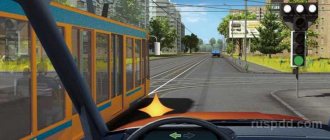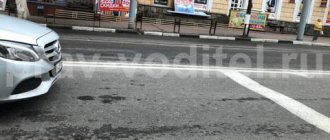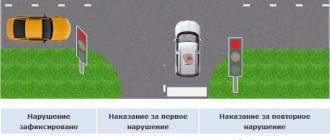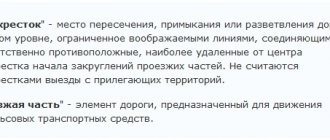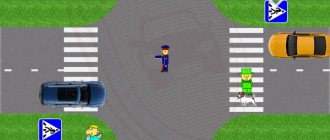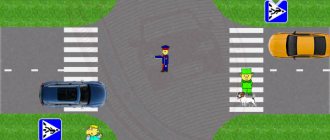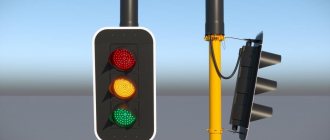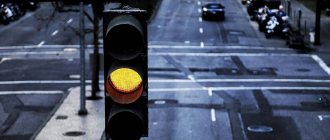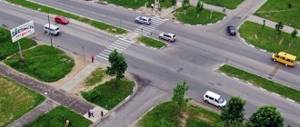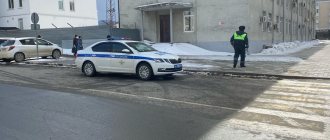The meaning of traffic light colors
It’s worth starting to analyze the correct actions when the green light is blinking by becoming familiar with the meanings of various traffic lights:
- green color of the order: encourages further passage of the regulated section;
- flashing permissive: allows movement, but warns that the signal will soon change to prohibiting;
- red continuous signal and red intermittent: prohibit movement;
- yellow signal: prohibits movement in all cases, except for the exceptions provided for in the traffic rules, informs about the change of green and red signals;
- combination of yellow and red colors: prohibits further movement.
As an exception, it is worth considering a situation in which a motorist cannot suddenly stop driving for objective reasons. Thus, the driver will not be able to stop driving without creating an emergency situation if another car is moving behind him, which does not expect an abrupt stop of the vehicle in front.
We are also talking about situations where the motorist has already entered the intersection at the time the signals change. Traffic rules prohibit the presence of a vehicle at an intersection for a long time, which means the driver must complete the maneuver and leave the intersection of roadways.
The situation is similar for pedestrians. When the signal changes to yellow or the traffic controller raises his hand (Stop signal), pedestrians must complete the crossing maneuver. If this is not possible, it is allowed to take a safe position on a safe section of the inverter or directly on a continuous one.
Thus, the flashing signal is intended to notify road users that they are approaching a dangerous section of the road. Places of increased danger may be unregulated pedestrian crossings, intersections and other areas.
Tram traffic light
T-shaped (tram) traffic lights are designed to regulate the movement of vehicles that have a dedicated lane for movement - in the vast majority of cases, for trams. They are usually installed in front of areas with limited visibility, before long ascents and descents, at the entrance/exit of tram depots, as well as in front of tram switches and intertwined tracks.
Typically, tram traffic lights have 2 signals: red and green. They are installed, mainly, either to the right of the tram track, or in the center above it above the contact wire. Traffic lights of this type operate automatically.
The main purpose of tram traffic lights is to signal to tram drivers that the part of the tram track following the traffic light is occupied. The effect of tram traffic lights applies only to trams.
Railway traffic light
Railway traffic lights are designed to regulate the movement of trains, shunting trains, as well as regulate the speed of dismantling from the hump:
- red - the path is busy, travel is prohibited;
- yellow - travel is allowed at a speed limit (40 km/h) until the next section of the stretch;
- green - 2 or more areas are free, travel is allowed;
- lunar white - an invitation signal (placed at railway stations, marshalling and freight stations).
Also, traffic lights or additional light signs can inform the driver about the route or otherwise specify the indication. If there are two yellow lights at the entrance traffic light, this means that the train will deviate along the arrows, the next signal is closed, and if there are two yellow lights and the top one is flashing, the next signal is open.
There is a separate type of two-color railway traffic lights - shunting ones, which give the following signals:
- one moon-white light - maneuvers are allowed;
- one blue light - maneuvers are prohibited.
Sometimes a railway traffic light is mistakenly called a semaphore.
River traffic lights
River traffic lights are designed to regulate the movement of river vessels. They are mainly used to regulate the passage of ships through locks. Such traffic lights have signals of two colors - red and green.
There are distant
and
nearby
river traffic lights. Distant traffic lights allow or prohibit ships from approaching the lock. Nearby traffic lights are installed directly in front of and inside the lock chamber on the right side in the direction of the vessel. They regulate the entry of ships into and out of the lock chamber.
It should be noted that a non-working river traffic light (none of the signals is lit) prohibits the movement of vessels.
There are also river traffic lights in the form of a single yellow-orange lantern, built into the “No anchoring” sign to indicate this sign at night. They have three lenses of the specified color, directed downstream, against the current and perpendicular.
Traffic lights in motorsport
In motorsports, traffic lights can be installed at marshal posts, at the pit lane exit and at the starting line.
The starting traffic light is suspended above the track so that it is clearly visible to everyone standing at the start. Arrangement of lights: “red - green” or “yellow - green - red”. The traffic lights are duplicated on the opposite side (so that all fans and judges can see the start procedure). Often at a racing traffic light there is not one red light, but several (in case the lamp burns out).
The starting traffic lights are as follows:
- Red: Prepare to start!
- Red goes out: Start! (start from a place)
- Green: Start! (running start, qualifying, warm-up lap)
- Flashing yellow: Stop engines!
The signals for a standing start and a rolling start are different for this reason. The fading red does not allow you to start reflexively - this reduces the likelihood that someone will move off at the “alarming” yellow light. During a rolling start, this problem does not arise, but it is important for the drivers to know whether the start has been given (if the judge considers the starting formation to be inappropriate, the cars are sent to a second formation lap). In this case, the green start signal is more informative.
In some racing series there are other signals.
Marshal traffic lights are found mainly on oval tracks and give the same commands that marshals give with flags (red - stop the race, yellow - dangerous section, etc.)
The traffic light in the pit lane has the following signals:
- Red: Leaving the pit lane is prohibited.
- Green: Exit from the pit lane is permitted.
- Flashing blue: a car is approaching the exit, give way to it.
In 2008, the Ferrari team used a traffic light instead of a sign to signal the driver during a pit stop. The system operated fully automatically, but during the Singapore Grand Prix, due to heavy traffic in the pit lane, the traffic lights had to be controlled manually. The mechanic mistakenly gave Massa the green light before the fuel hose had even been removed from the car, which led to the incident. After this, the team returned to the traditional sign.
Is it possible to drive if the green light is flashing and when there is a fine for this?
The law does not provide for a penalty for driving through a flashing traffic light. However, there are some nuances that not every vehicle owner is aware of. The main feature of driving through a flashing green light is when exactly it turned on.
If the green light starts flashing before entering the intersection, the driver will not have any problems. The fact is that government officials take into account not what signal was on while driving, but the traffic light instructions at the time of entry into the regulated area. So, if a driver entered an intersection when the green light was flashing, and completed the maneuver when the red light was on, there will be no offense.
Driving through prohibitory signals is regulated by the provisions of Article 12.12 of the Code of Administrative Offenses. According to this provision, the driver will be required to pay a fine of 1,000 rubles.
turned green
To decide who is at fault in a traffic accident, it is necessary to establish a cause-and-effect relationship. Those. determine the actions of which participant in the accident caused the accident.
In urban environments, most traffic accidents occur at intersections. Ideally, there should be no unregulated intersections in the city. The city authorities are striving for this practically and new generation traffic lights have been installed at all central intersections of the city. They are distinguished by increased light output, and the signals are clearly distinguishable in any weather conditions.
Now let's talk about a typical traffic accident at a controlled intersection. The scene is the city center. This is the crossroads of Abai and Gogol. Valid November 2008. Excerpt from the explanation of one of the participants in the accident: “I was standing in front of the stop line waiting for the green traffic light, and as soon as it turned on, I started moving, and then I saw a car (Toyota) rushing to my left along Abai Street at high speed, I stopped, but a collision could not be avoided.” The second participant in the accident claims that he drove into the green flashing signal and, naturally, blames the driver of the Zhiguli 2107, who started driving through the intersection, for the accident.
This is how accidents at signalized intersections usually happen, or something like this, and the most interesting thing about this is that both drivers claim that they were driving on a green signal, but one on the beginning of the green, and the other on the flashing green. Technically this cannot be. The traffic light operation scheme is designed in such a way that it absolutely excludes the possibility of turning on the permissive traffic light signal on intersecting streets. The conclusion is clear: one of the participants in the accident is telling a lie. In such cases, the traffic policeman who draws up the diagram of this accident charges both participants in the accident, paragraph of the Rules, with driving through a prohibiting traffic light signal. Let both prove their case in court, and that’s right. It may seem strange to us, but traffic accidents at signalized intersections are one of the most difficult to determine who is responsible for the accident and who is telling the truth and who is not.
In the absence of CCTV cameras, it can be very difficult; eyewitnesses of the accident are needed, but what if they are not there!? Most often, the one who started the movement is blamed. What suggests itself is clause 13.9. Traffic rules of the Republic of Kazakhstan . When the traffic light turns on, the driver is obliged to give way to vehicles completing their movement through the intersection, including pedestrians who have not completed the crossing. The old version specifically mentions that it is necessary to let through those vehicles that did not have time to complete the turn at the intersection.
This is relevant at “extended” intersections, for example, when exiting Abay Street from Baimagambetov and from Voinov Internationalistov. Drivers should not immediately start driving, but make sure that all vehicles have time to clear the intersection. Especially buses, which often do not have enough time to travel the entire distance of the intersection to the permitting signal. There are many such nuances in our traffic rules. And here is one of them, p – 5.6. drivers who, when the yellow signal turns on (in cases where the traffic signal operating mode does not ensure the green signal flashes, immediately before turning on (author’s note) cannot stop without resorting to emergency braking - they are ALLOWED TO MOVE. Permitted (but by no means obliges them to ) further movement. At the same time, no one relieves them of the obligation to act in such a way as not to create a danger to traffic and not cause harm ( clause 1.6 of the RK traffic rules ). Therefore, if the driver finds himself at an intersection when there is a prohibitory signal, he must clearly give realize that his actions go beyond the usual and may cause a danger that will not be long in coming, since the other driver is still moving towards the permission signal.
Based on the above, we note that the Legislative normative acts were drawn up in accordance with the available technical means of traffic regulation. Traffic lights without a green flashing mode are hopelessly outdated, they are now being replaced with new, more modern ones, but they still exist. This is generally an irreplaceable reality in road traffic, which was, is and will always be. Because technology, no matter how modern it is, fails at the most inopportune moment. And human intervention is necessary. The traffic controller, as a means of regulating and organizing traffic, was, is and will be!!!
I don’t understand how you can respond to a traffic controller’s prohibiting gesture, with your hand raised up with a baton - a stop signal for all drivers at the intersection. That is why he is a traffic controller, so that all drivers unquestioningly follow his instructions. When changing the signal, he makes gestures that are understandable to all drivers, with his free left hand, with the back of his hand directed at the driver, so that he stops and does not continue driving. The easiest way to determine which of the participants in an accident is lying is to find out the order of the traffic lights at a given intersection. When considering the above case, the court made a request to provide a diagram of the operation of traffic lights at this intersection.
And instead of a diagram, a disc with a video recording was provided, where it was clearly visible that the participant, who claimed that he had driven through the green flashing signal, had in fact crossed the border of the intersection at the yellow traffic light. Everything was resolved beautifully. You can’t argue against “video materials”; the guilt is obvious and proven. This is how the introduction of modern technologies, namely video recording at all key intersections of the city. Helps to organize traffic and avoid traffic jams and, most importantly, to record an accident in time and determine the guilt of its participants.
And lastly, it will be easier for the court to make a decision if witnesses are questioned in court. Therefore, do not enter into a discussion with another participant about who is to blame and who has a steeper “roof,” but look for eyewitnesses of the accident who will act as witnesses in court. Write down the telephone numbers and addresses of eyewitnesses immediately at the scene of the accident; witnesses who appear a week or a month later cause obvious mistrust.
When all intersections are equipped with video cameras, the process of identifying violators of the Rules and those responsible for accidents will be greatly facilitated. We hope that this happens as quickly as possible. Good luck to you, follow the Rules and don’t get into accidents, have a safe road.
3, total, today
Also interesting for you!
They didn’t leave, and somewhere in the yard!
Traffic rules and accidents
← Previous post
Next entry →
Leave a comment Cancel reply
What flashing indicates: allows or prohibits movement
According to paragraph 6.2 of the traffic rules, the flashing green signal is intended to notify motorists and pedestrians that the permitting signal will soon change to a prohibiting one. More modern traffic light models are equipped with a special display that displays the time remaining to complete the maneuver.
If the allotted seconds are not enough to cross the intersection at the same speed, the motorist should begin to gradually reduce speed and stop in time at the traffic light. This measure will ensure traffic safety not only for the driver himself, but also for the vehicles moving behind him.
If there is enough time before completing the maneuver, it is necessary to drive through the intersection or pedestrian crossing, taking into account the requirements of caution and safety. A decision to perform a maneuver is considered safe when the car is at a distance of 5-10 meters from the beginning of the regulated zone.
What do traffic lights mean?
The meanings of the main traffic lights, including flashing ones, are specified in section 6.2 of the Traffic Rules of the Russian Federation:
- green signal - you can start moving;
- yellow signal - the traffic light will soon change (driving is permitted only in one case, when stopping requires sharp braking and can lead to an emergency situation in front of the traffic light, at an intersection or at a railway crossing (Section 6.14 of the Traffic Regulations);
- red signal - you need to stop.
Driving through intersections in accordance with traffic regulations
The decisive circumstance when driving through intersections is the indication of a traffic light at the moment of entering the intersection of roadways or a pedestrian crossing. Thus, with a relatively small traffic light coverage area, a motorist can start moving when the signal is flashing without fear of being prosecuted.
If the driver did not have time to complete the maneuver and completes it at a prohibitory traffic light, the owner of the vehicle will be legally protected by the provisions of paragraph 13.7 of the traffic rules. This provision obliges the driver to leave the regulated area so as not to interfere with other traffic participants.
It is prohibited to start driving through a flashing signal only if there is a traffic jam directly behind the intersection. According to paragraph 13.2 of the traffic rules, the driver is prohibited from creating inconvenience to other road users in this way, even if the traffic light signal does not prevent the maneuver.
If the owner of the vehicle notices a flashing signal at a decent distance from the regulated zone, he must reduce speed and stop before the intersection. This is explained by the high probability of driving on a yellow traffic light, which is prohibitive. For such a violation, the motorist will be held accountable in the same way as for driving through a red light.
Should I drive through a flashing light?
Crossing an intersection while the traffic light is flashing often becomes the reason for drivers who want to save time to cross the intersection when the traffic light is prohibiting. Motorists justify their actions with the phrase “I couldn’t make an abrupt stop.”
This reasoning for the offense has no legal basis if the motorist deliberately increased his speed when approaching a regulated zone. In addition, most traffic lights today have a display counting down the seconds allotted for the maneuver. Therefore, traffic police inspectors will easily bring the violator to administrative responsibility for driving on a prohibited signal.
Road service employees can also be guided by part two of Article 12.12 of the Administrative Code of the Russian Federation. The regulation provides for a fine of 800 rubles for hitting a stop line and 1,000 rubles for driving onto a waffle marking after the traffic light switches to a prohibiting signal.
Prosecution
The legislative framework for holding motorists accountable for running a yellow traffic light is presented in subparagraph two of paragraph six of the traffic rules. According to this provision, driving on a yellow signal is equivalent to driving on a red one. Thus, the amount of the administrative penalty in both cases will be the same.
Driving through a prohibiting traffic light may result in the following administrative measures:
- for the first offense: a financial penalty in the amount of 1000 rubles;
- for repeated violation: 5,000 rubles or deprivation of the special right to drive a vehicle.
If a secondary offense is committed, the degree of responsibility will be determined depending on the accompanying circumstances and the general danger of the offense.
